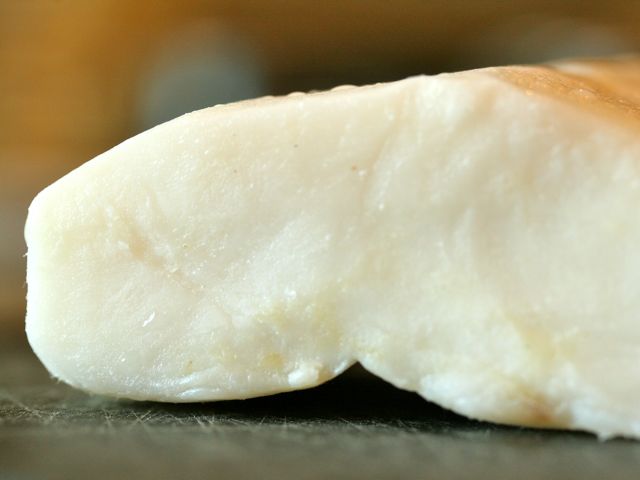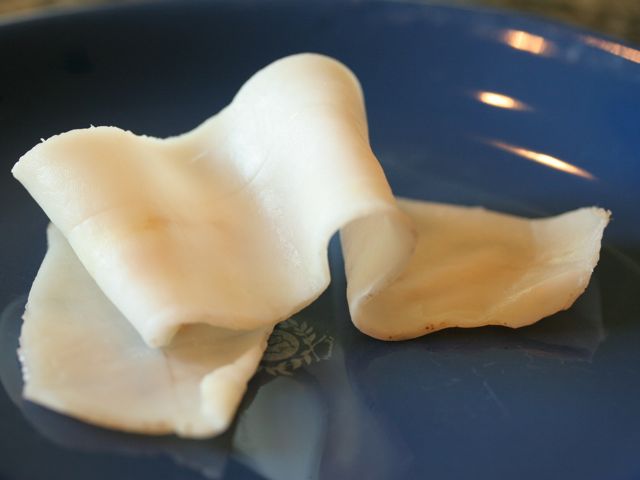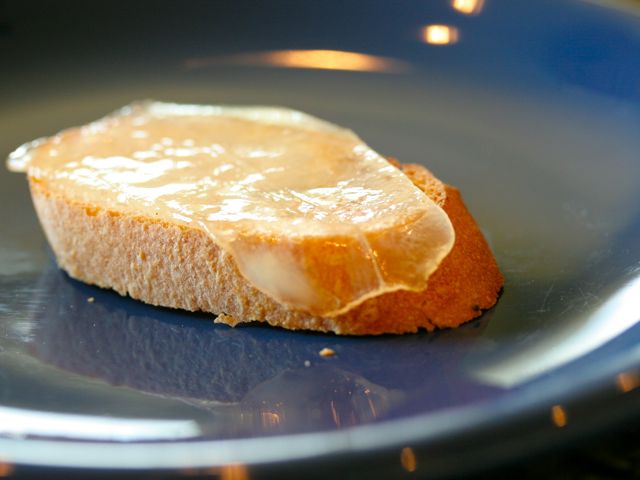
fatback, l
(article, Hank Sawtelle)
[%pageBreakSettings nobreak=true] I would love to make my own lardo. It is impossible to find anyone who sells it on the Web, and here in eastern Montana . . . forget about it. Hope you can help. Waiting anxiously. — Leda S., West Yellowstone, Montana Have you checked Wyoming? Just kidding. Your anxiousness is making me all anxious and stuff! Let's get this figured out. Lardo is Italian for lard, or more specifically, fatback — solid fat taken from under the skin on the back of a pig. OK, yeah, it sounds kind of gross in the abstract. But as part of the charcuterie tradition of using the whole hog and not just the muscley parts, it's pretty honorable. Not to mention the fact that almost everything tastes better with pork fat, and this is pure, unadulterated pork-fat flavor. [%image fatback float=right width=400 caption="To get lardo, you start with fatback."] So it's no surprise that many pork-eating cultures have found ways to use fatback. It's cured to make lardo (Italy) and salo (Eastern Europe). In French cooking, thin slices of fatback are often used to line the interior of a terrine mold, as it's a more elegant (and less smoky-tasting) option than bacon. And just about everyone who makes sausage uses fatback as necessary to adjust the meat/fat ratio of the grind. Sure, it's not low-cal diet food, but considering that pork fat has less saturated fat and less cholesterol than butter, it's nothing to be especially afraid of. To make lardo, fatback is cured with salt (and, depending on the recipe, sugar, herbs, and a small amount of nitrite). The main difference between lardo and bacon (which I [/columns/askhank/curingmeat "discussed last month"]) is that after curing, the lardo is air-dried to remove more moisture and intensify the flavor. You can definitely make lardo yourself! I'll get to that in a minute. Once cured, lardo is usually sliced thin and applied as a tactical flavor bomb. Chef Mario Batali puts lardo on pizza; at fancy-pants Italian/seafood restaurant Marea in New York, it's melted over sea-urchin roe on crostini. [%image lardo float=right width=400 caption="Lardo is usually sliced thin and applied as a tactical flavor bomb."] At home, you can wrap lardo around bundles of warm asparagus, or render it in a pan to sauté potatoes, or melt it on a slice of good warm bread, just to name a few ideas. Finding uses for lardo is easy; finding lardo for sale unfortunately is not. The lardo tradition dates back to ancient-Roman times, and the world's most famous lardo is still produced near the marble quarries of Colonnata in Tuscany. There, fatback is cured for months in vessels made of local marble. We're probably not going to duplicate the quality of Lardo di Colonnata, at least not on our first few thousand tries, so don't knock yourself out tracking down a marble curing vessel. A large baking dish will work fine. One step you can take, however, is to get a thick piece of the best-quality fatback you can find. (If you can't get fatback, you can use good pork belly; you'll end up with more of a stripy, bacony-looking product.) In the words of Michael Ruhlman and Brian Polcyn, authors of the (kick-ass) book Charcuterie: "Use excellent pork, preferably from a small farmer who raises his hogs naturally. Do not use any other kind of pork; it's simply not worth it from a flavor standpoint, and you're likely to wonder what all the fuss is about." Or, if you don't believe them, listen to Hank '"Hunter Shaw: “Don’t bother trying this with a factory pig. They’re bred lean and pumped full of nasty hormones and antibiotics, and those things tend to lodge themselves in fats. Go with a small grower who is raising pigs the old way.” Got it? Good. [%image breadsaltlardo float=right width=400 caption="Warm bread, with a melted slice of lardo and salt, makes a good snack."] Shaw's recipe instructs us to cover the fatback in salt, sugar, curing salt, herbs, and spices, then cover the whole thing in plastic wrap and add weight to the top to help force moisture out and make a brine. Shaw recommends a 12-day minimum brine. Ruhlman and Polcyn's recipe is similar, but they recommend doing the brining in the refrigerator. (The fridge brine seems to add a little safety margin by keeping the temperature below the bacterial danger zone during the curing stage.) After brining, rinse the pork and pat it dry, then poke a hole in one corner and hang it (easier if the skin/rind is still on) in the proverbial “cool, dark place” for a few weeks to air-dry. The hardest part of the recipe may be achieving the target environment of 50 to 60 degrees Fahrenheit and 60 to 75 percent humidity. (I'm going to try it in my rented locker at a climate-controlled wine-storage company, which shall remain nameless, as I'm sure they hate this idea.) Given the minimal protein and moisture content in the brined pork, my assumption is that air-drying lardo is less risky (in terms of growing naughty germs) than something like salami. Fingers crossed! I kid; there are numerous examples on the Web of folks making lardo at home and living to blog about it. If this sounds like more trouble than you're up for, Murray's Cheese sells American lardo (made by La Quercia in Iowa) online. It's a steal at $36 per pound plus shipping. Yikes. I assumed lardo would be easy to get in a food-obsessed town like Portland, Oregon, but it isn't. I called several local charcuterie shops, and the closest I got was a butcher who told me (over blaring Stone Temple Pilots music) that he “has some on cure, but it's still at least 10 days out.” Dammit! Time to track down some fatback at the farmers' market and get my own cure on. p(bio). Based in Portland, Oregon, Hank Sawtelle has engineering, legal, and culinary degrees.

fatback, l

lardo, l

breadsaltlardo, l

reference-image, l